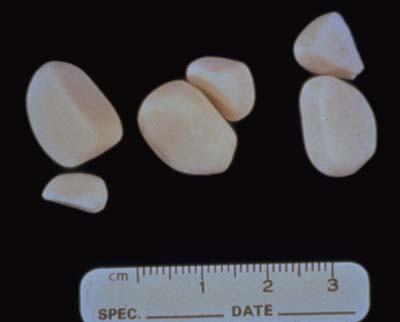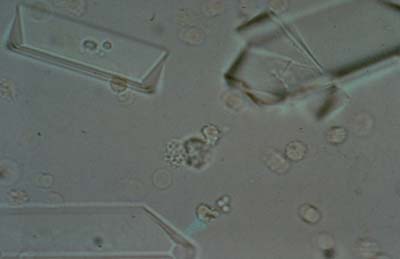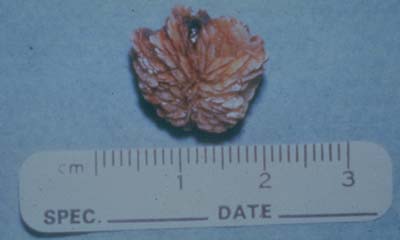Cystotomy
Introduction
- To access bladder lumen.
Uses
Indications
- Removal of cystic calculi in patients non-responsive to medical management, or male cats with risk of obstruction, when other methods are not available Urolithiasis.
- Catheterize ureters.
- Placement of ureteral stents.
- Bladder neoplasia Bladder: neoplasia.
- Repair of rupture Bladder: trauma rupture.
- Management of urethral rupture Urethra: rupture.
- Vesico-ureteral anastomosis Ureter: anastomosis.
- Investigation of hematuria Hematuria.
- Investigation of recurrent urinary tract infection (UTI) to sample calculi/bladder mucosa Cystitis: bacterial Feline lower urinary tract disease (FLUTD).
Advantages
- Easy to perform.
- Minimal morbidity.
- Requires minimal equipment.
Disadvantages
- More invasive than catheter or cystoscopic retrieval of calculi, or medical management.
- Risk of disseminating bladder neoplasia (TCC) Bladder: neoplasia.
- Hematuria Hematuria /clinical signs of cystitis post-operatively.
Alternative techniques
Cystic calculi
- Dietary adjustment and medical dissolution for calculi:
- Voiding urohydropulsion.
Urethral obstruction
- Retrohydropropulsion Urethra: obstruction.
If successful, should follow this with cystotomy and retrograde flushing of the urethra to prevent re-obstruction. - Urethrotomy.
- Urethrostomy, although this is best performed as an elective procedure Urethrostomy.
Time required
Preparation
- 30 min.
- Clip and aseptically prepare caudal abdomen.
Procedure
- 60-90 min depending on reason for cystotomy.
Decision taking
Criteria for choosing test
- Identify the type of stone before management if possible Urinalysis: centrifuged sediment


 .
. - Urine should always be cultured Urinalysis: culture and sensitivity (bladder mucosa and any calculi should also be cultured to increase yield).
Risk assessment
- If animal has urinary obstruction care with anesthesia as biochemical parameters, electrolyte and acid-base balance may be upset. Always obtain blood tests before surgery.
- Fluid therapy Fluid therapy: overview is mandatory especially if animal uremic.
- Attempts should be made to resolve metabolic anomalies prior to anesthesia/surgery.
Requirements
Subscribe To View
This article is available to subscribers.
Try a free trial today or contact us for more information.
Preparation
Subscribe To View
This article is available to subscribers.
Try a free trial today or contact us for more information.
Technique
Subscribe To View
This article is available to subscribers.
Try a free trial today or contact us for more information.
Aftercare
Subscribe To View
This article is available to subscribers.
Try a free trial today or contact us for more information.
Outcomes
Subscribe To View
This article is available to subscribers.
Try a free trial today or contact us for more information.
Further Reading
Publications
Refereed papers
- Recent references from PubMed and VetMedResource.
- Bednarski R, Grimm K, Harvey R et al (2011) AAHA Anesthesia Guidelines for Dogs and Cats. JAAHA 47 (6), 377-385 PubMed.
- Looney A L, Bohling M W, Bushby P A et al (2008) The Association of Shelter Veterinarians Veterinary Medical Care Guidelines for Spay-Neuter Programs. JAVMA 233 (1), 74-86 PubMed.
- Osbourne C A, Lulich J P, Kruger J M et al (2008) Analysis of 451, 891 canine uroliths, feline uroliths, and feline urethral plugs from 1981 to 2007: perspectives from the Minnesota Urolith Center. Vet Clin North Am Small Anim Pract 39 (1), 183-97 PubMed.
- Cannon A B, Westropp J L, Ruby A L et al (2007) Evaluation of trends in urolith composition in cats: 5, 230 cases (1985-2004). JAVMA 231 (4), 570-576 PubMed.
- White R N, Tick N T, White H L (1997) Naturally occurring xanthine urolithiasis in a domestic shorthair cat. JSAP 38 (7), 299-301 PubMed.
- Peterson S L (1991) Cystotomy closure - a comparison of the strength of appositional and inverting suture patterns. Vet Surg 20 (2), 83 PubMed.
- Radasch R M, Merkley D F, Wilson J W et al (1990) Cystotomy closure. A comparison of the strength of appositional and inverting suture patterns. Vet Surg 19 (4), 283-288 PubMed.
- Kolata R J (1984) Emergency treatment of urethral obstruction in male cats. Mod Vet Pract 65 (7), 517-521 PubMed.
- Osborne C A, Polzin D J, Klausner J S et al (1984) Medical management of male and female cats with non-obstructive lower urinary tract disease. Vet Clin North Am Small Anim Pract 14 (3), 617-640 PubMed.